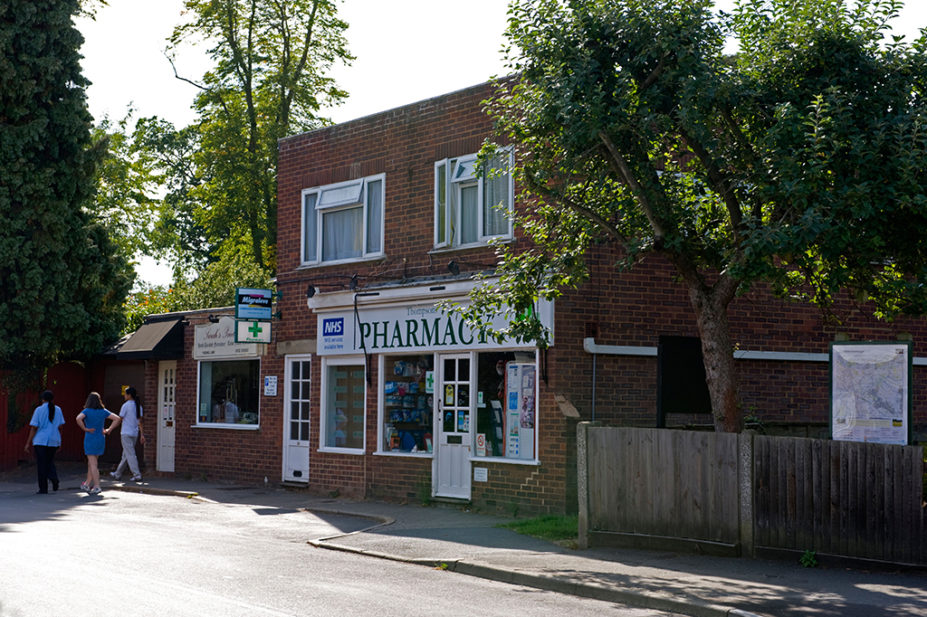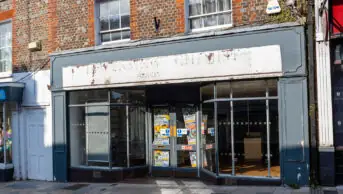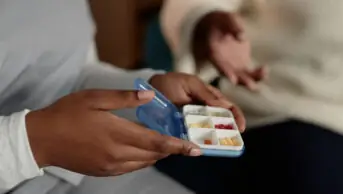
patrick nairne / Alamy Stock Photo
The ‘inverse care law’ is one of the most malign trends in healthcare. Defined by Welsh GP Julian Tudor-Hart in 1971, this ‘law’ stipulates that the more people need healthcare services, the least likely they are to have access to them.
This applies, for example, when it comes to accessing services offered by GPs, hospitals and dentists in deprived areas, with research showing that there are 1.4 fewer full-time equivalent GPs per 10,000 patients in the most deprived areas than in the least deprived areas. But it does not apply to one particular sector: community pharmacy — the shining exception to the rule.
Community pharmacy in England occupies a special position, with 80% of people a 20-minute walk away from one, and twice as many located in deprived areas.
This makes community pharmacy one of the most easily accessible healthcare providers in the NHS.
It is this fact that, in 2014, led researchers at the University of Durham to invert Tudor-Hart’s famous law, and outline the ‘positive pharmacy care law’, meaning people living in deprived areas have greater access to pharmacy services compared with those living in more affluent parts of the country (see Box).
And, for the first time, The Pharmaceutical Journal can reveal that it is not just the location of these pharmacies that obey this new law. They also provide more services on average too.
We linked the UK government’s indices of deprivation with the 4.2 million claims for NHS contractual services by community pharmacies in England, as reported monthly by the NHS Business Services Authority (NHS BSA) between October 2021 and September 2022.
The Pharmaceutical Journal found that pharmacies in parts of the country with high levels of ‘health deprivation and disability’ make 1.5 times the number of claims to the NHS for carrying out a contractual service (See Figure 1).
Between October 2021 and September 2022, on average, pharmacies in the top 10% most health-deprived areas of England — calculated based on the population’s risk of premature death and quality of life through poor physical or mental health — made 401 claims to NHS BSA for carrying out services such as the Community Pharmacist Consultation Service (CPCS) and the NHS Discharge Medicine Service (NHS DMS). This is compared with 266 such claims, on average, from pharmacies located in the 10% most healthy areas.
These services are vital in deprived areas, where people have been found to face multiple health problems more than a decade earlier than those living in affluent areas, and are more likely to have to manage prescriptions for ten or more different medicines in at least one month of the year.
For some services, the margin between the number of claims made in the most health deprived and most healthy areas is even larger. For example, on average, pharmacies in deprived areas claimed for 6 completed consultations each through the NHS DMS, while those in the healthiest areas claimed for 2 completed consultations each. Through the CPCS, on average, community pharmacies in deprived areas made claims for 95 consultations each, while those in the healthiest areas claimed for 46 consultations each.
Pharmacies in deprived areas dispense more items too — having provided patients with 106,203 items on average between October 2021 and September 2022, compared with 70,014 items on average from those in healthier areas.
This analysis shows that community pharmacies in deprived areas are invaluable at filling in gaps in the healthcare needed by their patients.
But the ‘positive pharmacy care law’ is in serious trouble.
An analysis of NHS Digital data by The Pharmaceutical Journal reveals that, of the 118 community pharmacy closures that occurred between October 2021 and September 2022, 27 were in the 10% most health-deprived areas, while just 5 were in the 10% most healthy areas of England (See Figure 2).
This fits with a recent analysis by the Company Chemists’ Association, which found that, between 2015 and 2022, more than 40% of community pharmacy closures took place in the most deprived parts of England, and a previous analysis by The Pharmaceutical Journal in 2021.
Closing any pharmacy is a bad thing, given access to healthcare is a well-established social determinant of health
Adam Todd, professor of pharmaceutical public health at Newcastle University’s School of Pharmacy
“Closing any pharmacy is a bad thing, given access to healthcare is a well-established social determinant of health; in deprived areas, where there’s greater health need, it is more of a pressing issue,” says Adam Todd, professor of pharmaceutical public health at Newcastle University’s School of Pharmacy.
Todd was the lead researcher on the study in 2014 that found 99.8% of people living in areas of high deprivation had access to a community pharmacy within a 20-minute walk, compared with 90% in other areas. The overall average has now dropped to 80%.
“The uniqueness of the community pharmacy network, in terms of accessibility, is the geographical distribution of them. So potentially, if this [trend of closures in deprived areas] continues to happen, the uniqueness of the community pharmacy network — and the positive pharmacy care law — could be in jeopardy,” he says.
This, in turn, could see a worsening of health inequalities in England, Todd warns.
The government’s ‘Levelling up’ white paper, published in February 2022, describes England’s health disparities as “striking”, adding that “COVID-19 has made these disparities more stark, with hospital admission and mortality rates higher among more deprived groups”.
To fix the problem, NHS England launched the Core20PLUS5 initiative in 2021, which aims to focus on people living in the 20% most deprived areas and identifies five clinical areas for improving health inequalities: maternity, severe mental illness, chronic respiratory disease, early cancer diagnosis and hypertension case-finding.
Integrated care boards (ICBs) were given £200m in 2022/2023 to help meet specific targets relating to these five areas, including to have “75% of [cancer] cases diagnosed at stage 1 or 2 by 2028”, but whether any of this funding has been passed on to community pharmacies is unclear.
There have been calls for similar initiatives in both Scotland and Wales. In July 2022, the Welsh NHS Confederation Health and Wellbeing Alliance called for the Welsh government to produce a “plan for reducing poverty and inequalities in adults and children” after a Public Health Wales report found that the COVID-19 pandemic had widened existing health inequalities in the country.
Similarly, in Scotland, a report by the Health, Social Care and Sport Committee called for urgent action in September 2022 to address health inequalities and make the issue “a major public health priority”.
Nevertheless, community pharmacies do have a clear role to play in two of these areas — early cancer diagnosis and hypertension case-finding.
In October 2021, community pharmacies were able to start offering the NHS Community Pharmacy Hypertension Case-Finding service as an advanced service. Since then, community pharmacists have checked the blood pressure of 479,260 patients through the service, with the average pharmacy in a deprived area — where the population is nearly twice as likely to die owing to cardiovascular disease — having offered 45 checks, compared with 33 checks in the country’s healthiest areas.
Community pharmacies will also soon be able to start directly referring patients for cancer screening as part of a pilot service in two parts of the country.
“We know that cancer incidence and also cancer outcomes for the majority of cancers is socio-economically patterned,” says Todd.
“Take lung cancer as an example — people from deprived communities are more likely to get lung cancer, but also to have a poor outcome from the disease. So, clearly, anything we can do to prevent disease, but also promote early disease detection, is massively important,” he says.
But he adds that “a lot of these initiatives stem from the concept that there’s more community pharmacies based in deprived areas”.
“If you’ve got a pharmacy that’s commissioned to provide services, to prevent disease, promote health and also reduce inequalities, and yet those services are no longer there for a community, I think it certainly doesn’t make much sense in terms of how this fits with the overall strategy of reducing inequalities,” says Todd.
“What we know from a well-established body of literature is that reducing healthcare services [and] closing pharmacies is potentially going to exacerbate health inequalities. I can’t see how it can do anything else.”
The number of pharmacies in England has been in steady decline since 2017/2018; a report commissioned by the National Pharmacy Association (NPA) and published in September 2022 warned of a “looming pharmacy collapse” that could see thousands of community pharmacies close without additional government funding.
This was a risk the government knowingly took when it froze funding for the sector at £2.592bn annually for five years. A government impact assessment of the ‘Community Pharmacy Contractual Framework for 2019/20 to 2023/24’ described “a risk that the introduction of new services or other requirements, or changes in prevailing market conditions during the five-year deal, could result in additional cost pressures arising”.
“In some circumstances this could mean pharmacies in certain locations become financially unviable and close,” the assessment said, warning that the contract “could lead to there being significant changes in the distribution of funding across pharmacies, creating a large number of winners and losers from the proposals”.
But that closures are even affecting pharmacies in high demand, such as those in deprived areas, “demonstrates just how fragile the community pharmacy network is”, says Janet Morrison, chief executive of the Pharmaceutical Services Negotiating Committee, who describes The Pharmaceutical Journal’s findings as “very worrying”.
“If even those pharmacies that are dispensing numerous prescriptions and offering plenty of services cannot make the sums add up, then something is clearly not right at the core of pharmacy funding,” she says.
“Pharmacies have a real role to play in most deprived communities to help reduce health inequalities — but only if those pharmacy businesses have access to fair funding levels. The government needs to intervene now to ensure that the vital service pharmacies provide to patients and the public is protected.”
Gareth Jones, director of corporate affairs at the NPA, adds that the “vital work” of providing more services to people in deprived communities “is no guarantee against being forced to close, given the woefully inadequate baseline level of NHS funding”.
If the government is serious about tackling health inequalities, it must grasp the funding nettle and invest public money in pharmacies across the board, including in those areas of greatest need
Gareth Jones, director of corporate affairs at the National Pharmacy Association
“In fact, dispensing is now frequently a loss-making activity, given the broken system of medicines reimbursement,” he says. “Meanwhile, there is also relatively little opportunity to supplement NHS funding with private income in areas where people have less to spend, for example, on cosmetics or travel vaccinations.
“If the government is serious about tackling health inequalities, it must grasp the funding nettle and invest public money in pharmacies across the board, including in those areas of greatest need.”
The government does have a scheme in place to support pharmacies in places where patient access is at risk. The Pharmacy Access Scheme (PhAS) was launched in 2016 (with an updated scheme launching in 2022) to give eligible pharmacies, such as those in deprived areas that are more than 0.8 miles from the next nearest pharmacy, an additional monthly payment of up to £1,458, depending on the number of items dispensed.
In addition to extra funding to curb the rate of pharmacy closures, Todd says the government needs to offer “a long-term strategy for community pharmacy”.
“How does community pharmacy align to the broader strategy of delivering healthcare services within primary care and reducing health inequalities?” he says.
“Because, at the moment, I think the strategy is to involve community pharmacy more, direct more people towards using a community pharmacy, for public health advice and for advice around minor illnesses. But yet, community pharmacies are still closing, so clearly this doesn’t make much sense.”
Todd says that one approach to reducing closures in deprived areas “could be to identify community pharmacies serving our most socioeconomically deprived communities and, through targeted intervention and funding, support them to deliver more services”.
“This approach has already been adopted in general practice with the ‘Deep End networks’ and appears to be successful.”
Deep End networks that are currently running in general practice aim to attract staff to work in more deprived areas and advocate for more funding, as well as develop new services to address unmet need in these areas.
A spokesperson for the Department of Health and Social Care told The Pharmaceutical Journal that it is “carefully monitoring access to pharmaceutical services and there remains twice as many pharmacies in deprived areas compared to less deprived areas”.
But Todd insists that the government is not doing enough to protect pharmacies in deprived communities from closures, when the risks to patients are so high.
“I still work in a pharmacy, and I have done for the last 15 years — the same pharmacy — and that pharmacy is in a highly deprived area. There’s no GP in that area, and indeed for people in the community to see a GP face-to-face would require a 15-minute car journey,” he says.
“If that particular pharmacy were to close because of a lack of funding, it would have catastrophic implications for the people in the local community. If something’s already being done to protect pharmacies, then this is not enough; more needs to be done.”
Box: Discovering the ‘positive pharmacy care law’
In 2014, researchers from the University of Durham mapped the location of all 12,000 community pharmacies open in England at the time and, using the assumption that the average person walks 1 mile in 20 minutes, found that 89.2% of the population has access to a pharmacy within a 20-minute walk.
But the study, published in the BMJ, also found that this varies by level of deprivation, with 99.8% of the population in the most deprived parts of England able to access a pharmacy within a 20-minute walk, compared with 90.2% of the population is the most affluent areas. They described a “u-shaped access curve”, with people in the least deprived and most deprived areas having more access to a pharmacy than those in the middle of the deprivation range.
The researchers concluded that they had “found evidence of a positive pharmacy care law”, with potentially “major implications for the commissioning of future services from community pharmacies in England”.


